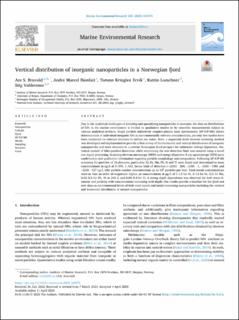| dc.contributor.author | Bruvold, Are Sæle | |
| dc.contributor.author | Bienfait, André Marcel | |
| dc.contributor.author | Ervik, Torunn Kringlen | |
| dc.contributor.author | Loeschner, Katrin | |
| dc.contributor.author | Valdersnes, Stig | |
| dc.date.accessioned | 2023-10-19T07:17:51Z | |
| dc.date.available | 2023-10-19T07:17:51Z | |
| dc.date.created | 2023-04-28T13:15:11Z | |
| dc.date.issued | 2023 | |
| dc.identifier.citation | Marine Environmental Research. 2023, 188 . | |
| dc.identifier.issn | 0141-1136 | |
| dc.identifier.uri | https://hdl.handle.net/11250/3097419 | |
| dc.description.abstract | Due to the analytical challenges of detecting and quantifying nanoparticles in seawater, the data on distributions of NPs in the marine environment is limited to qualitative studies or by ensemble measurements subject to various analytical artifacts. Single particle inductively coupled plasma mass spectrometry (SP-ICP-MS) allows determination of individual inorganic NPs at environmentally relevant concentrations, yet only few studies have been conducted on selected elements in surface sea water. Here, a sequential multi-element screening method was developed and implemented to provide a first survey of the horizontal and vertical distributions of inorganic nanoparticles and trace elements in a pristine Norwegian fjord prospect for submarine tailings deposition. Statistical control of false-positive detections while minimizing the size detection limit was ensured using a novel raw signal processing. Scanning electron microscopy (SEM) and energy-dispersive X-ray spectroscopy (EDS) gave confirmative and qualitative information regarding particle morphology and composition. Following SP-ICP-MS screening for particles of 16 elements, particulate Al, Fe, Mn, Pb, Si and Ti were found and determined to mass concentrations in ng/L of 1–399, 1–412, below limit of detection (<LOD) - 269, <LOD - 1, <LOD - 1981 and <LOD - 127 ng/L with particle number concentrations up to 108 particles per liter. Total metals concentrations were at least an order of magnitude higher, at concentrations in μg/L of 1–12 for Al, 2–13 for Fe, 0.3–11 Mn, 0.02–0.5 for Pb, 46 to 318 Si and 0.04–0.4 for Ti. A strong depth dependence was observed for both trace elements and particles with concentrations increasing with depth. Our results provide a baseline for the fjord and new data on environmental levels of both total metals and metal containing nanoparticles including the vertical and horizontal distribution of natural nanoparticles | |
| dc.description.abstract | Vertical distribution of inorganic nanoparticles in a Norwegian fjord | |
| dc.language.iso | eng | |
| dc.title | Vertical distribution of inorganic nanoparticles in a Norwegian fjord | |
| dc.title.alternative | Vertical distribution of inorganic nanoparticles in a Norwegian fjord | |
| dc.type | Peer reviewed | |
| dc.type | Journal article | |
| dc.description.version | publishedVersion | |
| dc.source.pagenumber | 10 | |
| dc.source.volume | 188 | |
| dc.source.journal | Marine Environmental Research | |
| dc.identifier.doi | 10.1016/j.marenvres.2023.105975 | |
| dc.identifier.cristin | 2144211 | |
| dc.relation.project | Norges forskningsråd: 299554 | |
| dc.relation.project | Havforskningsinstituttet: 15507–02 | |
| dc.relation.project | Havforskningsinstituttet: 15318 | |
| cristin.ispublished | true | |
| cristin.fulltext | original | |
| cristin.qualitycode | 1 | |
